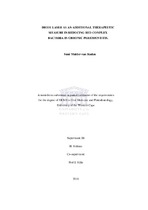| dc.contributor.advisor | Holmes, H | |
| dc.contributor.advisor | Hille, J | |
| dc.contributor.author | Mulder-Van Staden, Sune | |
| dc.date.accessioned | 2017-10-02T13:38:48Z | |
| dc.date.available | 2017-10-02T13:38:48Z | |
| dc.date.issued | 2016 | |
| dc.identifier.uri | http://hdl.handle.net/11394/5609 | |
| dc.description | Magister Chirurgiae Dentium - MChD | en_US |
| dc.description.abstract | This mini-thesis assessed whether a diode laser with a wavelength of 810 ± 10nm can be utilized as an adjunct to conventional management (i.e. scaling, root planing and polishing) of chronic periodontitis during initial phase therapy. Ethical approval and study registration (Reg no: 14/9/6) was finalized prior to commencement of the study. A split mouth randomised control trial was performed on 25 participants (who presented at the Oral Medicine and Periodontology Department of the University of the Western Cape) diagnosed with active, chronic periodontitis. In order to standardise the split mouth design the quadrants 1 & 4 were assessed together as a set and quadrants 2 & 3 were assessed as a set. A set of these quadrants were randomly assigned to either the test or control quadrants after conventional management was performed in all four quadrants. The base line bacterial colony collection (Micro-IDent®-11, Hain Lifescience GmbH, Nehren, Germany) and the clinical parameters were assessed prior to the commencement of conventional management and were reassessed at the 6 week re-evaluation visit. The set of test quadrants were treated with the diode laser as an adjunct to the preceding conventional management. The control quadrant only received the conventional management. Evaluation of the results demonstrated that the diode laser produced no statistical decrease in the bacterial parameters in the periodontal pockets and resulted in a statistical increase of C. showae (Cs) and T. denticola (Td). The clinical parameters resulted in no statistical difference for any clinical parameter, with the exception of the reduction in BOP that was statistically significant (p< 0,05) with the laser as an adjunct. It is the recommendation that within the limitations of this study, that the utilization of the diode laser (810 ± 10nm) as an adjunct at the initial visit had no statistical effect in the reduction of the bacterial parameters nor resulted in an overall improvement of the clinical parameters. | en_US |
| dc.language.iso | en | en_US |
| dc.publisher | University of the Western Cape | en_US |
| dc.subject | Polymerase chain reaction | en_US |
| dc.subject | Chronic periodontitis | en_US |
| dc.subject | Red complex bacteria | en_US |
| dc.subject | Periodontitis | en_US |
| dc.title | Diode laser as an additional therapeutic measure in reducing red complex bacteria in chronic periodontitis | en_US |
| dc.rights.holder | University of the Western Cape | en_US |

